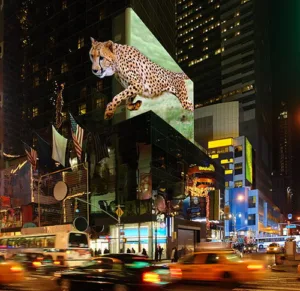TriLite Technologies (Vienna, Austria) is a 2011 start-up that proposes, among other things, large scale glasses-free 3D digital signage. And I mean large scale: one of their promotional pictures shows a 3D digital signage installation in Times Square, New York.

Photoshopped image from TriLite of a 3D display in Time Square
The image is Photoshopped, of course. TriLite doesn’t really have a display in Times Square, at least not yet. And if they did, no portion of the leopard would be outside the frame of the display. But their technology has the potential to produce a Times Square-sized glasses-free display, a potential I haven’t seen before in other 3D glasses-free technologies. I’ve thought in the past about using conventional autostereoscopic technology such as parallax barriers for a big public display but even conceptually, I couldn’t make the technology work. Part of the reason is maintaining the precision alignment that would be required, and part of the reason is the poor efficiency of parallax barrier technology would not allow a sign to be daylight readable.
To learn more about the TriLite technology, I got in touch with Ferdinand Saint Julien, a founder of the company and now the company’s Business Director. He says the company is currently looking for a manufacturing partner to take the technology beyond the prototype stage. He believes that the technology will be out on the streets in about two years’ time.
The key to glasses-free 3D display, whether it is a multiview autostereoscopic display or a light field display, is the ability to control the emission of each individual pixel as a function of direction – horizontally for 1D parallax or both horizontally and vertically for 2D parallax.
TriLite does this by using a scanning mirror coupled with its laser module in an assembly it calls a Trixel. The lasers can be modulated fast enough to generate, in TriLite’s words, “up to several thousand 3D viewing zones”. According to Saint Julien, TriLite is focusing on multi-view autostereoscopic rather than light field displays but I believe the optical technology could support a light field display as well. Massive computer support is required for light field displays so perhaps the company’s focus on the somewhat simpler multi-view autostereoscopic approach makes sense for now.
![]()
Array of TriLite Trixels, with one Trixel, the laser module and the micromirror highlighted.
The image, which was taken from a video posted by TriLite on its website, shows an array of Trixels, with one highlighted by a red boundary and arrows pointing to the laser module and the micromirror. According to Saint Julien, TriLite’s next generation prototype array will have a pixel pitch of 18mm, with the possibility of reducing pixel pitch over time. While LED pixel pitches are now pushing down toward 1mm, those fine pitch displays are intended for close-up viewing. For a large array in Times Square where viewers can’t get close to the display, an 18 mm pitch should be just fine. When large-scale LED arrays were introduced in the late 1990s, they had pitches of about 30mm.
What will a Trixel-based large screen display cost? Not surprisingly, Saint Julien declined to comment on the question. I suspect, if you have to ask, you can’t afford it. I’m guessing it will initially cost 5x – 10x the cost of an LED array with the same pitch, size and brightness.
For applications such as Times Square, this high price may not prove to be a barrier. TriLite says “According to a study recently performed, viewer recall of advertising in 3D increased by 22% compared to 2D. Likewise, purchase intent increased by 69%, ad liking increased by 24% and brand attitude increased by 8% from 2D versus 3D”. Advertisers should be willing to pay a premium to get this sort of viewer response.
In addition to 3D, a Trixel array can also show different 2D or 3D content in different viewing zones. To continue the Times Square example, pedestrians standing in front of the Disney store could see Disney ads, people in front of the Forever 21 store could see Forever 21 ads and people in front of the American Eagle Outfitters would see the AOE ads. Or perhaps American Eagle would decide to buy the space in front of the Forever 21 store, to tell people to cross Broadway and come to their store instead.
Some of the other applications proposed by TriLite are more problematical due to the cost. Would a sports stadium want a high-cost 3D display if most sports events at the venue are not shown in 3D? Would a highway department or an airport want a more expensive 3D display, even if it attracts more attention? As I see it, advertising and rental for special events, where the whole purpose is to attract attention, are the most likely short term uses of the technology.
TriLite was founded in August 2011 by Franz Fidler, now the company’s Technical Director, and Ferdinand Saint Julien. TriLite is funded by the European Union, the Austrian Research Promotion Agency and by private investors. The company has also partnered with the Göde Group in Bavaria. –Matthew Brennesholtz
Analyst Comment
When TriLite puts its first 3D screen in Times Square, rest assured I’ll be there to see it! (MSB)

